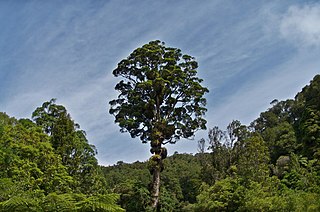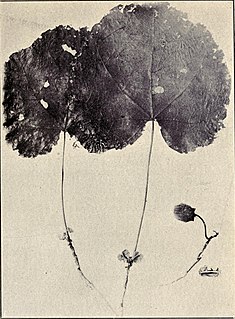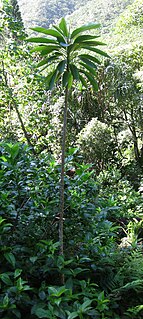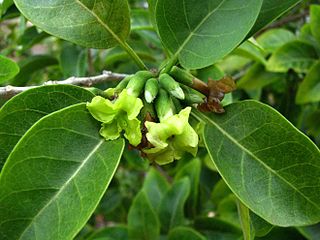
Inia is a genus of river dolphins from South America. It contains one to three species.

Metrosideros bartlettii, also known as Bartlett's rātā, Cape Reinga white rātā or in Māori as rātā moehau, is one of twelve Metrosideros species endemic to New Zealand and is notable for its extreme rarity and its white flowers, somewhat uncommon in that genus of red-flowered trees and plants. Its natural range is in the far north of the North Island at Te Paki, in three patches of dense native forest near Spirits Bay that escaped destruction by fire, namely Radar Bush, Kohuronaki Bush, and Unuwhao Bush. Only 13 adult trees are known to exist in the wild and most of these are either ill or dying. The lack of fossil evidence elsewhere suggests that the tree may always have been restricted to the North Cape area, which was an island until it was connected to the mainland by the sandspit that constitutes Ninety Mile Beach.

Metrosideros robusta, the northern rātā, is a forest tree endemic to New Zealand. It grows up to 25 metres (82 ft) or taller, and usually begins its life as a hemiepiphyte high in the branches of a mature forest tree; over centuries the young tree sends descending and girdling roots down and around the trunk of its host, eventually forming a massive, frequently hollow pseudotrunk composed of fused roots. In disturbed ground, or where there are gaps in the forest cover, Northern rātā will grow on the ground with a normal but short trunk.

Hibiscadelphus hualalaiensis is a species of flowering plant in the mallow family, Malvaceae, that is endemic to the Big Island of Hawaii. The last known plant died in 1992, making it most likely extinct in the wild; any remaining plants are threatened by habitat loss. It inhabits dry and mixed mesic forests on the slopes of Hualālai at elevations of 915–1,020 m (3,002–3,346 ft). Associated plants include ʻōhiʻa lehua, lama, māmane, naio, ʻālaʻa, pāpala, ʻaiea, poʻolā, and Kikuyu Grass. H. hualalaiensis is a small tree, reaching a height of 5–7 m (16–23 ft) and trunk diameter of 30 cm (12 in).
Kokia kauaiensis, the Kauai treecotton or Kauaʻi Kokiʻo, is a species of flowering plant in the mallow family, Malvaceae, that is endemic to Kauaʻi, Hawaii.
Salvia humboldtiana is a species of flowering plant in the family Lamiaceae that is endemic to Ecuador. Its natural habitat is subtropical or tropical dry valley shrubland.
Basselinia humboldtiana is a species of flowering plant in the family Arecaceae. It is found only in New Caledonia.

Euphorbia haeleeleana, the Kauaʻi spurge, is a species of flowering plant in the croton family, Euphorbiaceae, that is endemic to the islands of Kauaʻi and Oaʻhu in Hawaii. Like other Hawaiian spurges it is known as `akoko.
Metrosideros ochrantha is a species of plant in the family Myrtaceae.
Metrosideros punctata is a species of plant in the family Myrtaceae. It is endemic to New Caledonia. It is threatened by habitat loss.
Micropholis humboldtiana is a species of plant in the family Sapotaceae. It is found in Brazil and Venezuela.
Myrsine knudsenii, the Kokee colicwood, is a species of tree in the primrose family. It is endemic to the island of Kauai in Hawaii. It is threatened by habitat loss.
Nasa humboldtiana is a species of plant in the Loasaceae family. It is endemic to Ecuador. Its natural habitat is subtropical or tropical moist montane forests.

Nothocestrum breviflorum, commonly known as smallflower ʻaiea, is a species of tree in the nightshade family, Solanaceae, that is endemic to the island of Hawaiʻi. It inhabits dry and mixed mesic forests at elevations of 180–1,830 m (590–6,000 ft). These forests are dominated by ʻōhiʻa lehua and koa or lama, while plants associated with smallflower ʻaiea include wiliwili and uhiuhi. N. breviflorum reaches a height of 10–12 m (33–39 ft). It is threatened by habitat loss. It is federally listed as an endangered species of the United States. There are fewer than 50 individuals remaining.
Pancheria humboldtiana is a species of shrub in the family Cunoniaceae. It is endemic to New Caledonia where it is rare and found only on a few mountains.
Pleomele hawaiiensis, the Hawaiʻi hala pepe, is a rare species of flowering plant that is endemic to the island of Hawaiʻi in the state of Hawaii.

Xylosma crenata, the sawtooth logwood, is a species of flowering plant in the willow family, Salicaceae, that is endemic to the island of Kauaʻi in Hawaii. It is a tree, reaching a height of 46 ft (14 m). Sawtooth logwood inhabits montane mesic forests dominated by koa and ʻōhiʻa lehua at elevations of 975–1,065 m (3,199–3,494 ft). It is threatened by habitat loss.

Boto is a Portuguese name given to several types of dolphins and river dolphins native to the Amazon and the Orinoco River tributaries. A few botos exist exclusively in fresh water, and these are often considered primitive dolphins.
As of July 2016, the International Union for Conservation of Nature (IUCN) lists 238 conservation dependent species. 0.29% of all evaluated species are listed as conservation dependent. The IUCN also lists seven subspecies and five varieties as conservation dependent.
Clermontia samuelii is a rare species of flowering plant in the bellflower family known by the common name Hana clermontia. It is one of several Hawaiian lobelioids in genus Clermontia that are known as `oha wai. This plant is endemic to Maui, where there are fewer than 250 mature specimens remaining. This is a federally listed endangered species of the United States.








